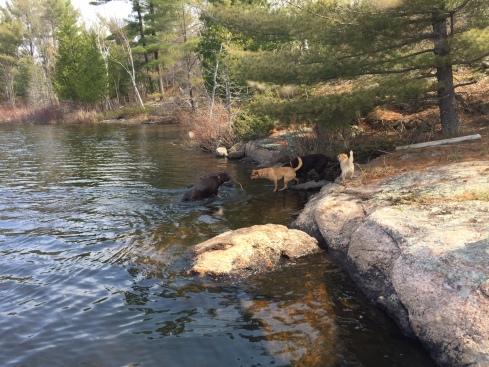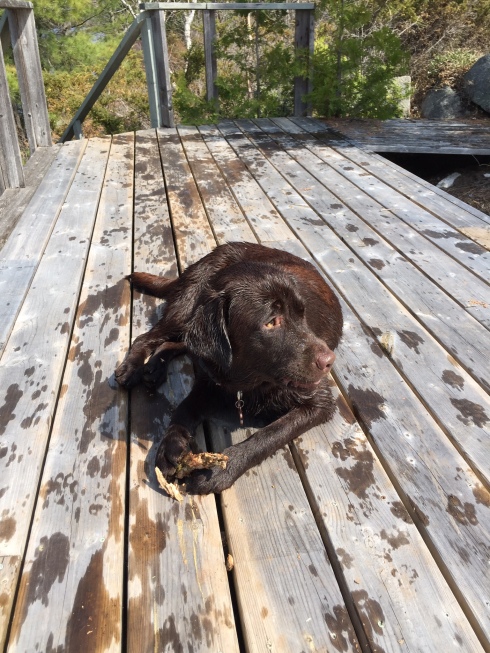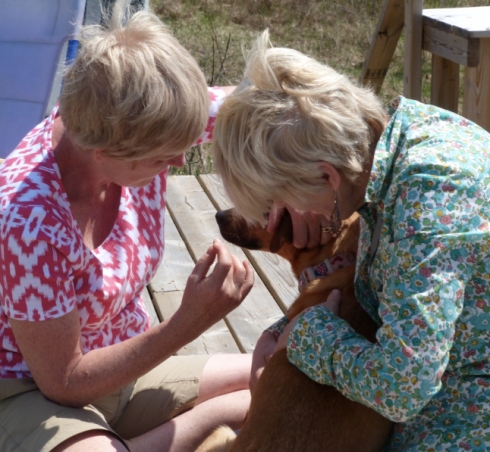Sydney woke me up with her shaking and shivering and chattering of teeth several times during the night. Not a good sleep for me, worse for her I suppose. I wonder if she is not only suffering from some neurological disturbance but also a little night time anxiety.
Here is a photo of Sydney the Wonder Dog as a young girl standing down by the lake after a refreshing dip.

Syd and I trotted over to Mum’s cabin this morning and as I opened the screen door, I felt something drop on to my arm then fall to the ground. Here’s what fell, a lovely little toad. I call it a toad because of the warty looking skin and when I used the amphibians of North America book to identify it, the closest match was the Grey Toad.
But I suspect it is actually the Tetraploid Gray Treefrog, a species more common to Ontario.
Tetraploid Gray Treefrog (Hyla versicolor)
- has the ability to change colour, from greenish-gray to gray-black
- the skin appears mottled, bumpy and toad-like. It is often referred to as a tree toad
- each toe has a toe disc, which aids in climbing
- has 48 chromosomes which is twice that of other North American species of Hyla
Habitat:
- inhabits trees and shrubs close to temporary or permanent bodies of water
- after breeding in the spring they move away from the wetlands and into the forest
Cockroaches??!!
Big controversy here – a few roach, beetle looking things have been seen in both cottages. This isn’t a great picture, because this poor specimen has been squashed by my foot before having its portrait taken. David at the Bakery was insistent that they were wood beetles – but, after a careful review of the insect guide, it looks like they are indeed cockroaches! The brown cockroach, to be exact.

There was a huge issue because several groups insisted they were cockroaches and that if we didn’t kill them all, we’d be overrun and never get rid of them. I’ve been reading up on them and it looks like they need heat and humidity to survive. Since the uninsulated, unheated cottage will be spending many months suffering through an intensely cold winter, I suspect we’ll be OK by spring. If not, I’ll get the exterminator in.
Tags: Amphibia, chocolate lab, cockroach, frog, grey toad, toad




 Just before leaving for the cottage, Piper was diagnosed with Lyme Disease – most likely from a tick she picked up at the cottage on a previous visit last spring or fall. The ticks are REALLY on the rise! After each walk with the dogs, we would give them the once-over looking for the little beasts. We always found several. I have removed 3 off myself, so humans are not immune. Tick season is spring and fall so summer visitors may not be afflicted too badly, but I’d suggest that all dogs get good tick repellant and humans do regular checking. Andrea is now a tick removing expert.
Just before leaving for the cottage, Piper was diagnosed with Lyme Disease – most likely from a tick she picked up at the cottage on a previous visit last spring or fall. The ticks are REALLY on the rise! After each walk with the dogs, we would give them the once-over looking for the little beasts. We always found several. I have removed 3 off myself, so humans are not immune. Tick season is spring and fall so summer visitors may not be afflicted too badly, but I’d suggest that all dogs get good tick repellant and humans do regular checking. Andrea is now a tick removing expert.

















